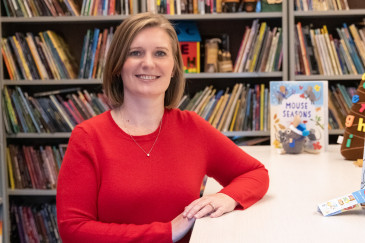
Independent research team awarded Institute of Education Sciences grant
“Teachers are the most essential factor in student success. However, according to a recent report by the National Council on Teacher Quality, only 25% of teacher education programs adequately address all five core components of reading instruction when preparing teachers for literacy instruction,” said Nick Gaehde, president of Lexia, a Cambium Learning Group brand.
For this reason, a team of three independent researchers have received a $4 million, five-year grant from the Institute of Education Sciences to investigate the impact of Lexia LETRS (Language Essentials for Teachers of Reading and Spelling), Lexia’s teacher professional learning program in literacy. It is used by more than 250,000 educators in 47 states, and in over 2,500 school districts.

Shayne B. Piasta, professor of literacies, literature and learning, is a co-principal investigator of the grant and Ohio State’s lead researcher. A developmental psychologist by training, she is internationally known for her more than 16 years of commitment to science of reading research. She has had multiple, major federal grants to determine effective practices for teaching reading.
Young-Suk Kim, professor and senior associate dean, School of Education at University of California – Irvine, is the principal investigator. Ben Kelcey, also a co-principal investigator, is professor of quantitative research methodologies at the University of Cincinnati.
They were brought together by their shared interest in understanding how supporting teachers’ knowledge may link to their use of effective literacy practices in classrooms, and, ultimately, to better reading outcomes for children.
All three have independently studied elements of this logic chain during their careers. Piasta, for example, completed an impact study of a prior Ohio professional learning experience aimed at supporting early childhood educators’ language and literacy instruction.
“Although research — and logic — suggest that professional learning programs can benefit teachers and students, most programs have not been rigorously and independently evaluated,” Piasta said. “We want to be sure that time, money and other investments in professional learning lead to the positive outcomes we expect, especially if such programs are being mandated."
Piasta also noted that many teachers in Ohio have already completed LETRS or very similar professional learning opportunities, per state science of reading requirements. California has been slower to adopt such requirements, which is why the impact study will be implemented with teachers located there.
How the study will be conducted
Kim, Piasta and Kelcey will study the effects of Lexia LETRS on implementation (including fidelity), teacher knowledge, literacy instructional practices and student literacy outcomes in grades K-3. They will examine students’ language, reading and writing across two years.
The randomized controlled trial will involve approximately 60 schools, 240 teachers, and their students in southern California. The researchers will use a multi-district, school-level randomized control trial design in which schools, and therefore teachers, are randomly assigned to LETRS or business-as-usual conditions. This is important, because Lexia LETRS is designed for schoolwide participation and reform.
The target region serves students in primary grades from diverse racial, ethnic and socioeconomic backgrounds.
Teachers assigned to the LETRS condition will complete the full LETRS training over 2 years. The course teaches the skills needed to provide high-quality reading and writing instruction — phonological awareness, phonics, fluency, vocabulary, comprehension and written language.
The researchers also will calculate the cost of implementing LETRS at multiple levels (i.e., overall cost for implementation and per class) accounting for expenditures for personnel (e.g., teachers), facilities and materials. They will estimate the cost per student and per class and the cost effectiveness of the program.
The Institute of Education Sciences grant was awarded through a competitive, independent review process. IES is the statistics, research and evaluation arm of the U.S. Department of Education.




